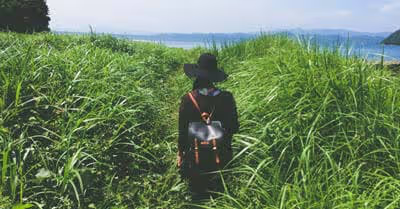Table of Contents
The best GPS for hiking in 2020
1) Garmin Montana 680t
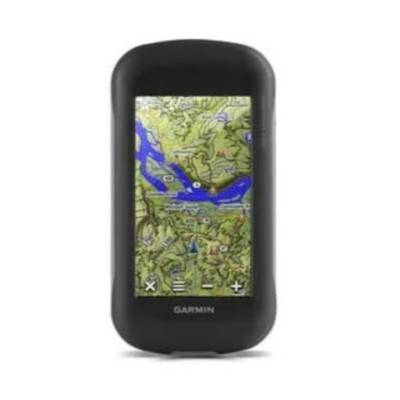
Garmin Montana 680t
Interesting features:
- Unusually good maps
- Built-in camera
- Large touch screen
- Three-axis compass
The Garmin Montana has much better maps than most of the alternatives do. Most of the time, the maps that a GPS comes with are not of good quality.
People usually download new maps to replace the poor maps that their GPS devices come with. You have to pay money to download the best maps.
The Garmin Montana comes with 100,000 detailed maps of different parts of the United States. Unless you plan to use the GPS outside of the country, you won't need any other maps.
The Garmin Montana not only uses American GPS signals to determine your location but Russian GLONASS signals as well. By using both types of signals, the Garmin Montana helps pinpoint your location as accurately as possible. While this is not a unique feature, it does help to make the Garmin Montana better than most of the competition.
Another exciting feature is its built-in camera. This might come off as a gimmick, as you probably have a smartphone with a camera anyway, but it does help the Garmin Montana stand out. The Garmin Montana is a relatively expensive and fancy GPS with features that go beyond the usual.
The Garmin Montana also has a large touch screen, plus a three-axis compass so that you can tell what direction you are facing while standing still. The Garmin Montana is excellent but relatively expensive. For a cheaper but somewhat more basic alternative to the Garmin Montana, you could try the Garmin Oregon.
2) Garmin eTrex 22X
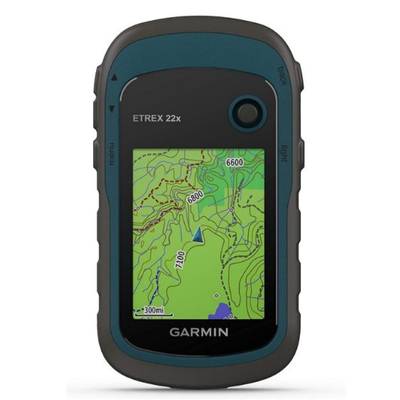
Garmin eTrex 22X
Interesting features:
- Uses replaceable AA batteries and drains power slowly
- Reasonably resistant to water
- Screen is readable in sunlight
- Slot for memory card
The Garmin eTrex 22X is an excellent choice if you are looking for something as reliable as possible. The eTrex both has a long battery life (25 hours) and uses disposable AA batteries that you can change at any time. The eTrex is also water-resistant, so this is one of the more durable GPS devices.
As well as offering 8GB worth of memory, the Garmin eTrex has a slot for a microSD card. If you buy a microSD card separately and insert it, you can greatly increase the amount of available memory. You can store up to 200 routes and 2000 waypoints in the device's memory.
Another reason to recommend the eTrex is that its screen is bright enough to read in sunlight easily. Trying to read a GPS screen in the glare is annoying, so the sunlight-readable screen is a significant advantage. The eTrex is also a reasonably cheap product.
3) Garmin GPSMAP 66i GPS Handheld and Satellite Communicator
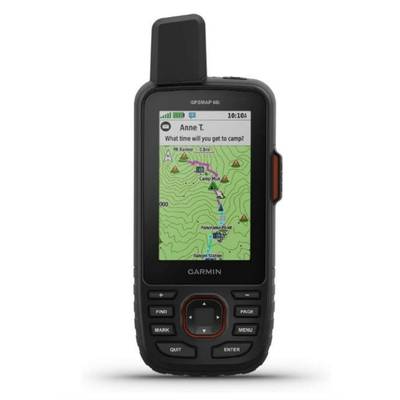
Garmin GPSMAP 66i GPS Handheld and Satellite Communicator
Interesting features:
- Tracks a lot of information about your trip
- Can be used to send email and text messages from anywhere
- Good for emergencies
The Garmin GPSMAP 66i allows for two way satellite communication. This allows you to send and receive text messages from anywhere in the world - even if there is no cell phone service.
The Garmin GPSMAP 66i tracks plenty of information about your hiking trip, such as how fast you travel and what the total distance of your trip was. You can see a complete map of the route you took.
Hiking certainly has its dangers, and the Garmin GPSMAP 66i allows you to send an SOS message to the authorities with your exact location. Since it works as a satellite communicator, it is great for emergencies and can save your life.
One possible disadvantage of the Garmin GPSMAP 66i is that it uses a rechargeable lithium-ion battery and not AA batteries that you can easily replace. The lithium-ion battery runs out after only 35 hours of actual use. The Garmin GPSMAP 66i is not very cheap and does not have a touch screen.
4) Satmap Active 20
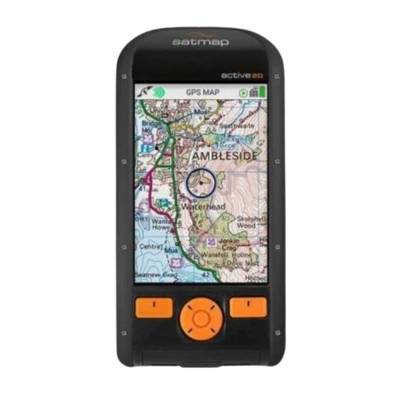
Satmap Active 20
Interesting features:
- Both a touch screen and buttons
- Difficult to break and waterproof
- Map sharing, altimeter, GLONASS support
- High-end device with lots of advantages
Although the Satmap Active 20 is larger, heavier, and more expensive than our other offerings, it offers so many advantages that you might consider it. If you want to minimize how much you have to carry around during your hikes, don't bother with it, but otherwise, this is an excellent device.
The Satmap Active 20 is not only quite resistant to water but to shock as well. A light fall will not break your GPS. Even the screen is reinforced and relatively hard to break.
The Satmap also offers both a touch screen and buttons. This way, you can use the touch screen most of the time but use the buttons if you are wearing gloves. The interface is quite good, and you can intuitively move the map around and zoom in on it.
The Satmap is a high-end device that tries to offer everything. It has a barometer and altimeter, support for sharing maps, GLONASS as well as GPS support, and a large and high-quality screen. However, it is not for everyone - some find the GPS too bulky to take hiking.
5) Garmin Oregon 700
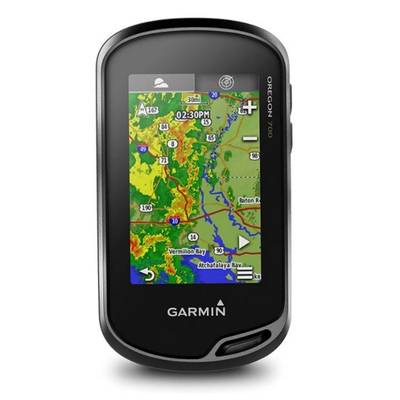
Garmin Oregon 700
Interesting features:
- Elevation tracking
- Route tracking and maps
- Resistant to water
The Garmin Oregon 700 is a great choice if you are looking for something cheaper than but reasonably similar to the Garmin Montana. The Garmin Oregon is not very basic and offers a lot of features for its moderate price.
The Garmin Oregon has a large, high-quality touch screen, route tracking, and maps, plus water resistance. The Garmin Oregon even tracks your elevation as well.
The Garmin Oregon is not as fancy as the Garmin Montana - it does not have a camera, for example. The Garmin Oregon is a high-quality GPS with a relatively standard list of features.
6) Magellan eXplorist 310 Waterproof Hiking GPS
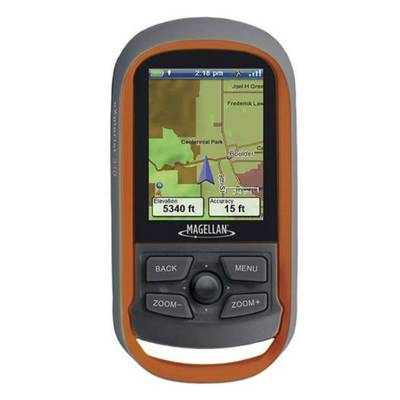
Magellan eXplorist 310 Waterproof Hiking GPS
Interesting features
- Uses standard AA batteries
- Much cheaper than many other options
- Particularly water resistant
Magellan is not as well known as Garmin, but they do make durable and long-lasting products. If you are looking for a small and light GPS that has a lot of features in spite of its small size, consider the Magellan eXplorist 310. The Magellan eXplorist is specifically designed for hikers.
The Magellan ships with reasonably good maps installed, which is impressive for such an inexpensive device. Better maps are out there, but you might not bother to replace the acceptable default maps. The Magellan is also easy to use; this is much less true for more complicated Garmin products.
The screen is possible to see in the sun, and the Magellan is very water-resistant, so much so that even dropping it in a creek will not wreck it. What it lacks is standout features - there is no camera, and there are no networking features.
7) Delorme InReach Explorer
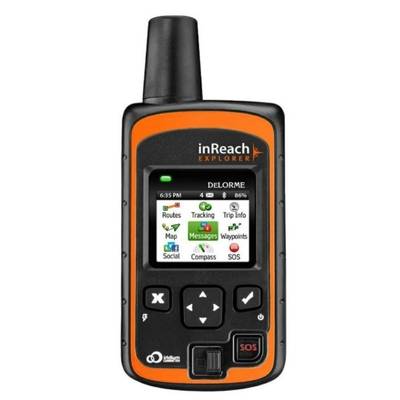
Delorme InReach Explorer
Interesting features:
- Particularly good for sending an SOS message
- Allows you to send text messages outside of cell phone range
- Altimeter and barometer
- Communicate with people from anywhere in the world
The Delorme InReach Explorer is another GPS that allows two-way communication with satellites, so you can text people in areas where cell phone use is normally impossible. The satellite communication also makes the Delorme a great choice for emergencies because you can text back and forth with the authorities who can tell you when they will arrive.
Another advantage of the Delorme is that you can download maps with the GPS device itself, and do not need a laptop to get new maps.
There is one major disadvantage of the Delorme, which is that you have to pay a monthly fee to use the product. This is sort of understandable as you are getting access to global Iridium satellites, but the monthly fee will no doubt keep many of you away. It is the best choice if you want a GPS that can keep you safe in remote areas without cell phone coverage.
8) Garmin GPSmap 64
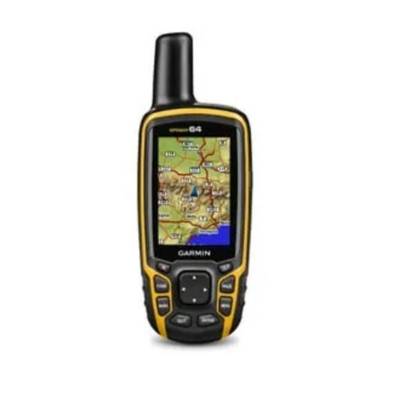
Garmin GPSmap 64
Interesting Features:
- Reliably finds a signal in difficult conditions
- Birdseye satellite imagery
- Small size and lightweight
While the GPSmap 64 does not have a touch screen like many other Garmin products do, it is still worth considering. The best thing about the Garmin GPSmap 64 is the accuracy and reliability of its signal.
It receives data from both GPS and GLONASS, and its powerful antenna pinpoints your location accurately. In areas where obstacles can interfere with a typical GPS signal, the GPSmap 64 might be able to get a clear signal despite the difficulty.
If you are willing to pay a subscription, you can use BirdsEye Satellite Imagery. This allows you to combine satellite photographs with your maps, making your navigation much easier. The GPSmap 64 can often still get a good signal in canyons or in deep forests where an average GPS would be unable to pick up a signal.
9) Suunto Traverse
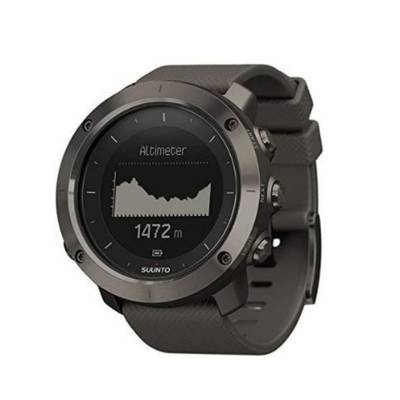
Suunto Traverse
Important features:
- Altimeter and compass
- Lightweight and convenient
- Interacts with cell phones
- Works as a fitness tracker
A GPS watch might sound like a gimmick, but these products have their advantages. The Suunto Traverse is very light and fits on your wrist like a watch, a far cry from the large and heavy handheld GPS. If you are going for a short hike and don't want to bring a full-sized GPS with you, the watch might come in handy.
It takes no time at all to check your position on a GPS watch. You can also ride a bike, climb, and so on while having a GPS watch on your wrist. With the Suunto Traverse, you can keep your hands free.
You might assume that the features of a GPS watch would be very basic, but there are more features than you would think. You can plan and follow a route, label different locations you find, and check your elevation. The Suunto Traverse can even receive notifications from your smartphone.
10) Garmin Foretrex 401 Waterproof Hiking GPS
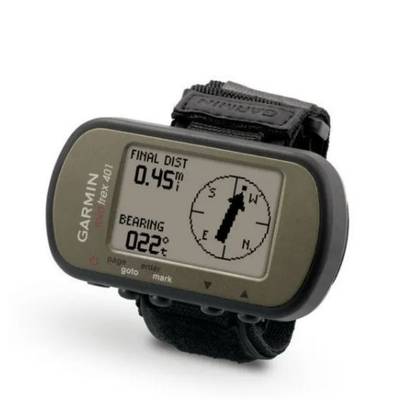
Garmin Foretrex 401 Waterproof Hiking GPS
Interesting features:
- High sensitivity receiver
- Keeps track of your route
- Compass and altimeter
The Garmin Foretrex 401 is another choice if you are looking for a wearable GPS. It is not shaped like a watch, but it is held on by a wristband.
One disadvantage of either the Suunto Traverse or the Garmin Foretrex is that there is no map. Some trade-offs have to be made to make GPS devices small enough to be wearable, and that includes getting rid of the maps. You can still know your location and see your route, but without maps, these products are less useful than full-sized GPS devices.
Compared to the Suunto, the Garmin Foretrex is more likely to get a strong signal in a difficult environment. On the downside, the Garmin does not work as a fitness tracker the way the Sunnoto does. You can get a heart rate tracker for the Garmin, but you have to buy it separately.
Buyers guide for a hiking GPS in 2020
When getting a GPS, make sure you get one that is well suited for hiking. A GPS that is ideal for driving a car or being out with a fishing boat might not be ideal for hiking.
For example, I would not buy a GPS with a battery that runs out quickly and takes it hiking. The battery should last a long time, and you should be able to change and not merely recharge the batteries.
It would be best if you got a GPS that uses disposable AA batteries instead of rechargeable lithium-ion batteries. You cannot easily charge your GPS when out hiking, so disposable batteries are a better choice.
Cold weather will drain your batteries up to a few times faster than warm weather will so carry several extra batteries in colder weather. Depending on where you carry your GPS, you may be able to keep it warm in colder weather. Carry it inside a warm coat pocket with a zipper, and it may stay warm for a long time.
Type of screen
Some GPS devices have noticeably better screens than others. A better screen is larger and is a touch screen. Many devices rely on buttons instead of a touch screen and have only a small display.
While I prefer a touch screen and do not find that it has any disadvantages, some other people prefer buttons. Depending on the weather, you might not want to take your gloves off, and in that case, buttons are easier to use.
A larger screen looks better and is easier to use, but it also drains your battery faster. If you don't mind a small screen, a smaller screened device often has more battery life. However, I prefer larger touch screen devices and do not find them to have any significant disadvantages.
Size and weight
A larger, bulkier GPS that does not fit in your pocket easily is not the best idea for hikers. Some hikers do not mind relatively large or heavy devices but keep how much room you have to carry it around with you in mind.
Water resistance
A good hiking GPS is durable, not delicate. This includes being resistant to water - your GPS could easily get rained on at some point, and that should not be enough to wreck it.
Networking capability
With some devices, you can share maps, waypoints, and objectives with your friends by sending each other this information wirelessly. Some GPS devices also double as walkie talkies or short-range radios. Two-way radio capability can make hiking with your friends more fun and can save a life in an emergency.
Track logs
This is one of the more interesting features a GPS might offer. With a track log, you can follow the path you took on your hike back in the other direction and retrace your steps. Many devices also let you manually add labels and information to your maps.
A good three-axis compass
With some devices, you can only tell which direction you are going in when you are moving. With others, you have to hold the GPS perfectly flat to tell what direction you are going in while standing still. You can avoid these hassles by buying a GPS with a three-axis compass that will always be able to tell which direction you are facing.
Extras to go with your GPS
When you get a GPS, there are some accessories you want to consider buying with it. These extras don't cost much and can make more than a little difference.
The first extra you might consider is an antenna. If you buy a longer external antenna to go with your GPS, you can get good reception in a place where your signal would otherwise be poor.
You might also buy a mount for your GPS, or buy more navigation data for your GPS to give you more detailed information about where you are going.
Software for your GPS
If you want to make the most of your GPS, you need the right software. If you hook your GPS up to a computer, you can download and install new maps that make your GPS more useful.
The map that an average GPS comes with is not very good and does not have much detail. You can find a better map that is specifically for hikers and much more detailed. This will take a bit of extra time and usually cost a bit of extra money.
A robust warranty
Last but not least, you should make sure that your GPS is backed up by a strong warranty. If the warranty is weak and doesn't last for very long, this implies that the company is making a cheap product that they expect to break. Only spend money on a GPS that is guaranteed to work properly and last.
Recent Articles














